DOI:10.32604/iasc.2021.018770

| Intelligent Automation & Soft Computing DOI:10.32604/iasc.2021.018770 |  |
| Article |
Intelligent Model Of Ecosystem For Smart Cities Using Artificial Neural Networks
1School of Computer Science, National College of Business administration and Economics, Lahore, 54000, Pakistan
2College of Computer and Information Sciences, Jouf University, Sakaka, 72341, Saudi Arabia
3Department of Computer Science, Faculty of Computers and Artificial Intelligence, Cairo University, 12613, Egypt
*Corresponding Author: Muhammad Asif. Email: muhammadasif@ncbae.edu.pk
Received: 20 March 2021; Accepted: 21 April 2021
Abstract: A Smart City understands the infrastructure, facilities, and schemes open to its citizens. According to the UN report, at the end of 2050, more than half of the rural population will be moved to urban areas. With such an increase, urban areas will face new health, education, Transport, and ecological issues. To overcome such kinds of issues, the world is moving towards smart cities. Cities cannot be smart without using Cloud computing platforms, the Internet of Things (IoT). The world has seen such incredible and brilliant ideas for rural areas and smart cities. While considering the Ecosystem in Smart Cities, there is a considerable requirement to improve the model to make life better. This proposed research integrates a city into a smart city using the Internet of Things (IoT) which focuses on the smart ecosystem. In this research work, a model is proposed to overcome an ecosystem’s IoT and Machine Learning techniques issues. The Levenberg-Marquardt (LM), Bayesian Regularization (BR), and the Scaled Conjugate Gradient (SCG) algorithms are implemented with an ANN-based approach named to empower the ecosystem of the smart city while developing an efficient and smart ecosystem model. The proposed method’s evaluation indicates that the BR algorithm achieves promising results concerning accuracy and miss rates. The predicted accuracy of the proposed model shows 91.55% performance of the ecosystem on the given factors.
Keywords: Ecosystem; machine learning; artificial neural network; smart city
Most of the world’s rural population is migrating to urban areas. One of the UN reports stated that, by the end of 2050, more than 60% of the world population will migrate to urban areas. This seems to be a large number and facilitates inhabitants, and cities need to be more facilitated, equipped with innovative, intelligent, and modern technologies. In these particular situations, Information Technologies can bind with the city’s local governments. It can be the breakthrough for implementing innovative, intelligent, and smart applications with privately-owned local businesses. The Internet of Things is one of the major domains that play an important role in creating such applications for all major industries and humans. With the Number of human in-creases in urban areas, IoT is rapidly growing with advancements in intelligent devices like sensors, gadgets, house equipment, etc. On the other hand, IoT devices were not possible to be intelligent without the advancements of hardware devices, sensors networks, and IoT devices and networks interconnected. With their interconnectivity, the world is exploring a new way of life [1,2].
On the other hand, Cloud services boosted the IoT, sensing devices, and actuation resources to build great innovative solutions to the world. But as known that, still there is a way long to make everything to the expectations and so that, there are still a few more challenges in the current system, such as:
According to ICT patterns, sensing and actuation tools can be included in the Cloud, and solutions for the integration and evolution of IoT and cloud computing infrastructures exist. Nonetheless, there are certain obstacles to overcome, such as:
The ability of different devices among different systems of ICT. The devices should process the large real-time scale of data provided, and devices can deploy those large amounts of data into smart systems. Etymologizing fragmentation of the multiple smart devices and their architectures are associated with the middleware involved in them. Heterogeneous resources are sometimes mixed up and need a smart system to treat those mixed up at various Clouds levels [3].
Regarding the last point, when talked about smart systems, the talk will be about the cloud services concept. Cloud services and IoT are interconnected with each other. Cloud Services play the role of connectivity with the IoT, with the people on the Internet and the internet services provider. With this theory, a new term is discovered, named Cloud of Things (CoT).
Regarding the last point, the Internet of Things (IoT) definition, with underlying physical structures abstracted according to thing-like semantics, appears to be a good starting point for orchestrating the various tools. In this sense, the Cloud paradigm may help link the Internet of Things with the Internet of People through the Internet of Services, allowing for horizontal convergence of disparate silos. This horizontal integration and Cloud computing will be refereed associated with the IoT as the Cloud of Things (CoT). Advancement of the assembly of differing IoT stages and Clouds experiences appropriately planned and executed reflection, virtualization, and the board of things. An exact structure of these instruments will allow the advancement of mechanical rationalist architecture. The joining and sending of various gadgets and items can be considered by disregarding their fundamental engineering [4].
Urban areas are transitioning from sophisticated to smart urban communities, computerized or astute urban communities that are more creatively arranged reciprocals of smart city ideas. When a city is instrumented, in-reconnected, versatile, self-ruling, learning, self-fixing, and vigorous, it moves closer to being “smart”. As illustrated in Fig. 1, sections of its base and offices unite people and update ICT to deliver their citizens and other partners’ administrations.
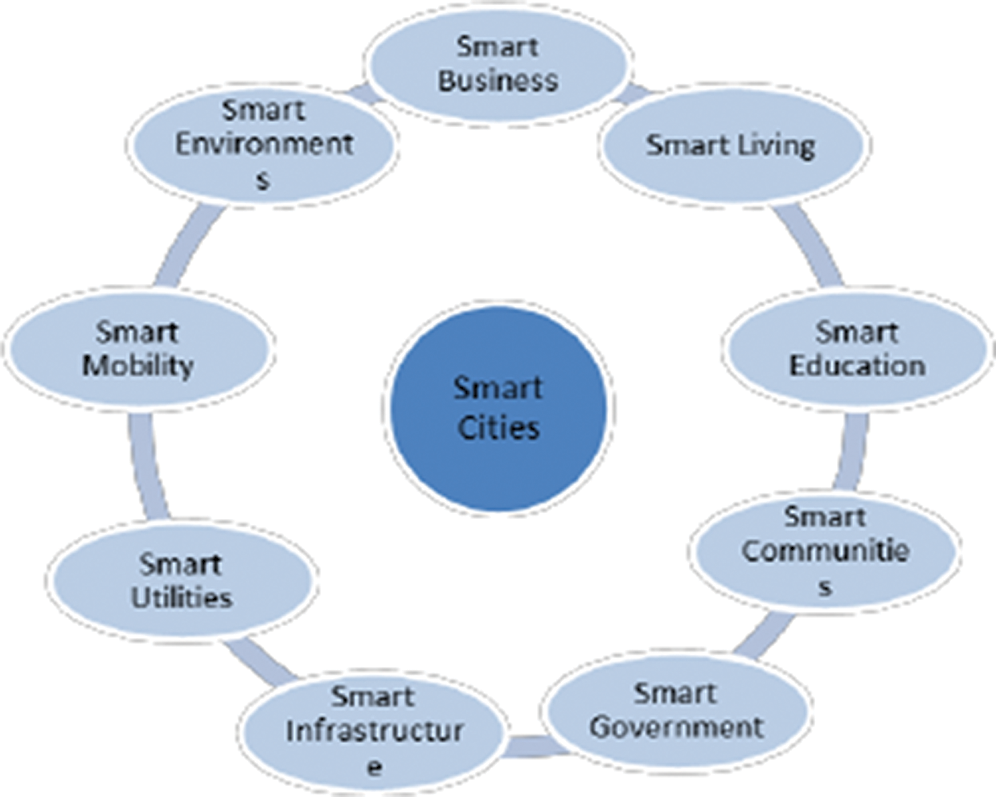
Figure 1: ICT with different Natives
My explanation’s main purpose is to talk about the overall reference structure for an urban IoT plan. It will define the major factors, features, and properties involved around the urban city at the IoT level. It will explain the importance of major services like energy, water, and an urban city ecosystem for all government sections.
Urbanization is the process which is related to the Economic Development, Social-Economic the administration of urbanization, and occupants’ prerequisites, and the world has presented the diver’s administration policies for future smart cities like technology, connectivity, sustainability, comfort, safety, social and cultural protection, and pleasing quality shape of the effective milestones to attain the better way of life, which led to the implication of “Smart Cities”.
In the 20th century, the Smart city was like a fiction concept for most of the population. In any case, on account of the telematics concept and the gadget’s knowledge, the “Smart City” becomes the achievable reality [5]. Moreover, the utilization of Information and Communication Technologies (ICTs) is a significant factor that empowers and makes it easy for urban areas to end up in Smart Cities. Accordingly, Smart City is established in clever frameworks formation and ICTs-Human association. The city development must regard these three tomahawks [6]: Sustainability improves the city/condition relationship and utilizes a green economy. Smartness; setting mindful economy and administration. Comprehensiveness; by cultivating a high-work economy conveying social and regional attachment.
The Internet of Things (IoT) is the interconnection of numerous devices like portable, vehicles, gadgets, and various things that are embedded with equipment and can work alongside the product, programming, sensors, actuators, and accessibility which involves these things to interface and exchange data (BROWN, 2016). IoT and Smart City have a hard bond relation; without IoT, no city becomes Smart City.
Fig. 2 shows IoT features fluctuate starting with one area then onto the next space. Some of the core features of IoT explore during the case studies are as follows:
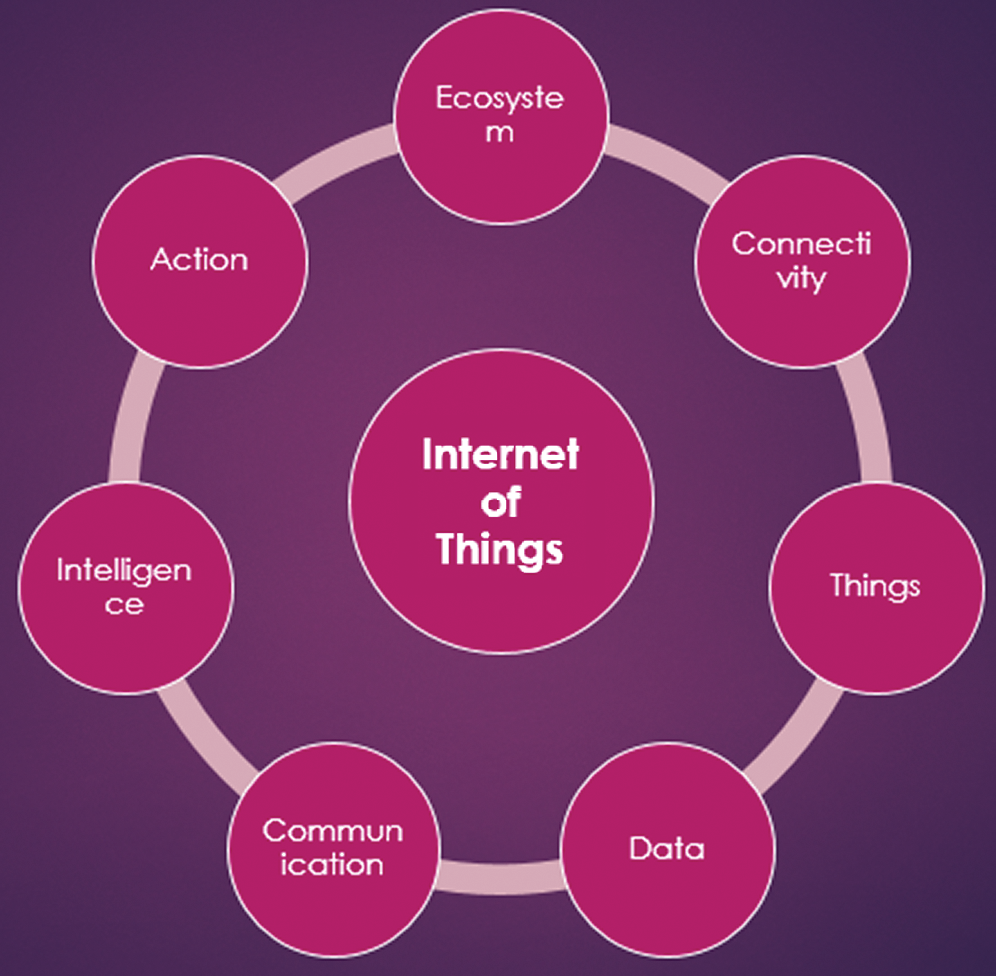
Figure 2: Features of IoT
IoT combines hardware and software, algorithms, and combinations of different associations between various gadgets.
Different IoT devices interact with each other through proper connectivity, which empowers them to communicate daily. Availability of these articles is urgent because basic item level collaborations contribute towards aggregate insight in IoT arrange, which empowers organize openness and similarity in the various gadgets. With this availability, different new open doors are made in the market with equipment and programming assistance.
IoT sensors bring offline networks to active networks; without an active network, IoT devices cannot bring real-life IoT devices. The IoT devices are used to detect and measure real-time changes in the IoT devices and reports based on results they detect. Without Sensors, there could not be an active and effective IoT environment.
Data play a role as a communicator between devices and the network; without effective and useful data, the IoT devices will not communicate as per the expectations. Suppose all the properties of the related data are described in good manners. It will be easy for IoT devices to communicate with each other, so in this case, data plays a vital role between networks and IoT devices.
IoT makes things reasonable and upgrades life through the use of knowledge the IoT devices have. Artificial Intelligence (AI) is a very important factor in making devices more intelligent and effective in doing jobs. If we have an AI base Ice Cream maker machine, and if the flavor ends, then with the AI integrated, it will generate an alarm to the merchant to refill the flavor.
IoT devices mostly aim to incorporate the physical world using the virtual world with the Internet’s help as the medium of communication. As for the IoT devices are a concern, future net-works will continue to be heterogeneous, multi-vendor, multi-tasking. Most importantly, they will be largely disrupted on a large scale. Still, consequently, the non-interoperability will increase too. So, Interoperability between IoT devices is a key challenge for the coming years.
When we talk about smart IoT devices, we alternatively talk about the devices that can adapt to the situation and learn easily with past experiences. Without the nature of devices to be intelligent, no device can be smart.
IoT ecosystems are interconnected with cloud services, AI devices, and different applications for consumers and businesses. On the other hand, most world users think that the ecosystem is small and not worth it. As most of the world’s rural population is moving to urban areas, it is very important to make our environment eco-friendly. To do so, we need eco-friendly devices. To keep in mind this, companies are moving towards Eco-friendly devices; one of the eco-friendly examples is the Tesla car.
The Smart city is an intricate biological system of individuals, firms, strategies, innovation, and different empowering influences cooperating to convey many results. The smart city isn’t “possessed” exclusively by the city. Other worth makers are additionally included, once in a while working in a joint effort and now and then independent from anyone else. Fruitful and economically smart urban areas adopt an automatic strategy to connect with their partners over the ecosystem system.
2.10 Role of Planet in Smart City
To date, many cities have not approached smart city strategies with an ecosystem perspective. This is partly because smart city initiatives are overseen by Information Technology (IT) agency, whose mission is to design and implement systems. Smart city projects are managed by internal cross-functional “Transformation” or “Innovation” organizations in more seasoned smart cities [7].
Notwithstanding where urban communities are in their shrewd city venture, they should stretch out beyond the “bend” with savvy city ventures. They start by speculation as far as structure the more extensive ecosystem system to make a feasible and versatile savvy city. The key subsequent stages are to Comprehend the smart city biological system structure and adapt it to their particular city’s substances. Fuse this model to improve their brilliant city vision, procedure, and implementation plans [8]. Concerning the smart city environment system, distinguish current abilities and holes over the different layers. Comprehend what is expected to help the four sorts of significant worth creators.
Assess existing and new savvy city ventures and activities against the environment outline work. Utilize this system to distinguish what is absent from the undertaking plans and what is expected to make the ventures completely fruitful. Determine which competencies should be prioritized and developed across the various ecosystem layers. A smart city necessitates the acquisition of new skills and competencies. As required, complement existing capabilities by forming strategic alliances and contracting with service providers.
Smart City can be classified into six aspects:
• Environment
• Economy
• Governance
• Living
• Mobility
• People
These are key focuses for answers for the real divergences of urban advancement, and the board of these subjects will prompt a smarter city [9].
Numerous nations and urban communities are trying to create smart urban communities, and some of them have developed a brilliant situation, savvy portability, and shrewd vitality, among others. One of the enormous issues for smart urban communities, be that as it may, is realizing how to deal with the immense amounts of data produced by associations, frameworks, and individuals consistently [10]. However, the proper research and analysis of this data can lead to the information, helping build a smart city [11].
According to [12], the mix of vital approaches and procedures are essential for smart urban areas, advancing manageable advancement, financial development, and better conditions for its residents. In this sense, Data Mining (DM) and Machine Learning (ML) procedures are pivotal for applications including smart urban communities since they aid issues including urban advancement, for example, recognizing areas that need checking by cops, handling of traffic, etc. [13].
Although enthusiasm for advancing smart urban communities, there is still an absence of agreement in current writing about the real impacts of these methods on urban communities. What’s more, most research investigates explicit issues, not concentrating on DM and ML’s job in savvy urban areas. Applications of IoT are shown below in Fig. 3.
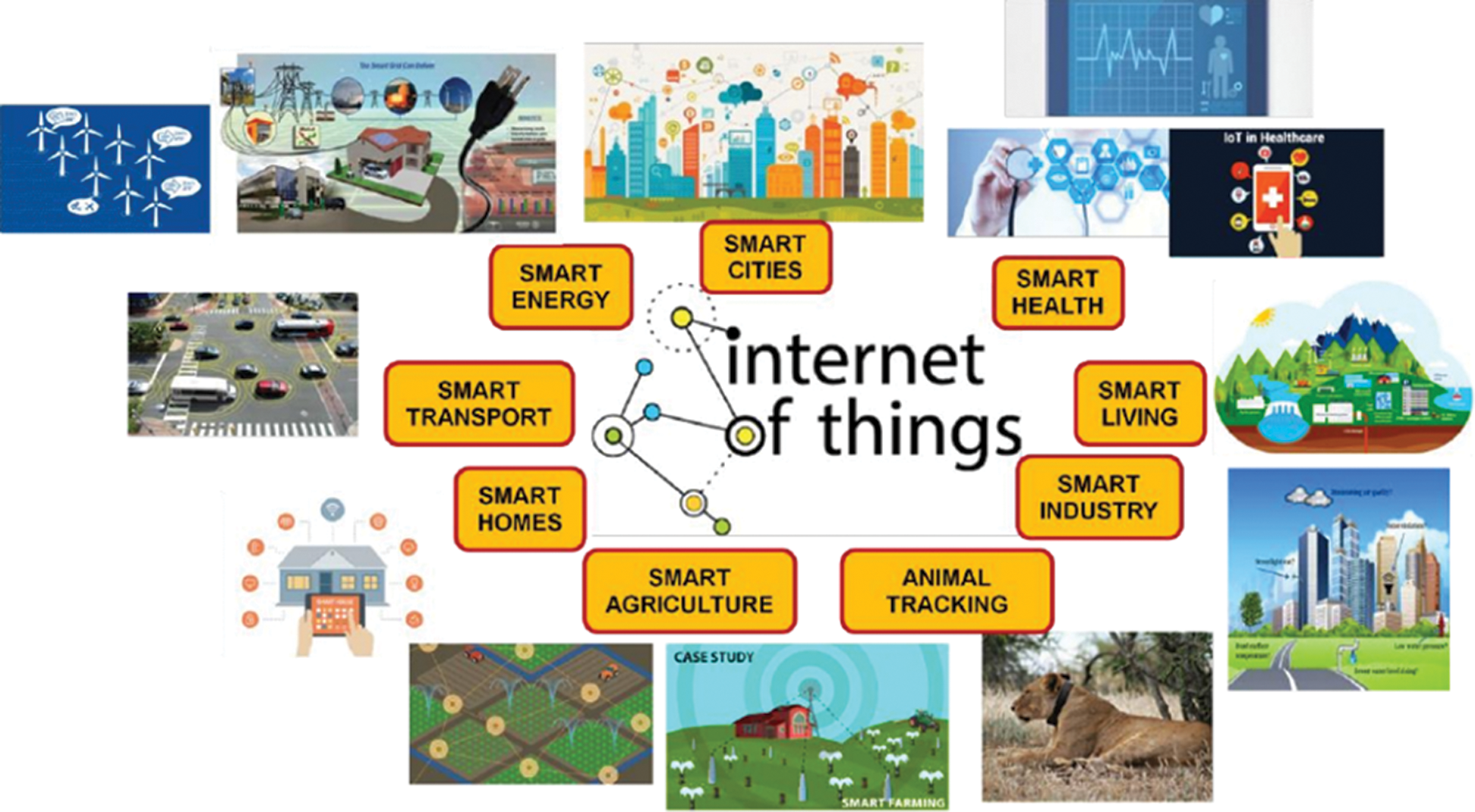
Figure 3: IoT applications
Tab. 1. shown the planet factors of a smart city. The smart city contains five subcomponents like Energy and mitigation, Materials, Water and Land, Pollution & Wastage, Ecosystem, and Climate Changes.

According to a report, at the end of 2050, more than 70% of the world populace will migrate from rural to urban areas population. That equates to another 2.5bn people live in cities, which was estimated at 4.2 billion in 2018 [15]. In such a rapid case of growing urban population, there is much need for sustainable energy, Transport, and Infrastructure sectors, to make a better, smarter and better way of living. Energy and mitigation play an important role in making a city Smarter [16].
2.11.2 Material, Water, and Land
One of the major issues of any city is the leakage of water and material. To make the water supply by 24 × 7, leakage removal is essential. For better water and material management, various smart tools or equipment are used to eliminate or detect leakage at various levels. “World can live without love, but no one can live without water. – W.H. Auden”.
According to World Health Organization (WHO), the death rate will increase enormously due to air pollution and can be in thousands rather than in hundreds between 2030 to 2050 [17]. The global air pollution problems extend to the majority of the world countries. This is due to a large number of migrations of rural population to the urban areas. Pakistan’s major cities like Karachi, Lahore, and Peshawar face many pollution and wastage issues due to many migrants. In this case, pollution and wastage is an important factor for cities to make them smarter.
An essential and reasonable city is an environment involving single clients to the network level, organization and business, laws, and processes integrated to create the most vibrant and adaptive smart city. One of a smart city’s major agendas is to make the city digital and innovative for peoples, with digital and smart tools of Transport, education, healthcare, and better options for better living standards.
Countries all over the world have set an ambitious target for reducing greenhouse gas emissions. Cities will need to use considerably fewer resources if certain goals are met. The revolution of Urban pollution and the industrial revolution directly impact the environment. With these revolutions, a new debate started that “how is responsible,” to what extent these problems are “man-made,” and what can be done to get rid of these crises.
The proposed model based on Machine Learning and AI, which describes how the hardware and software, physical gadgets communicate with each other and will help in building a smarter ecosystem for the smart city. The proposed model present in more detail and in advanced form, which gives more accurate results, and on that basis, the system can measure and evaluate the outcomes. The proposed system also helps us make better policies for any perspective of life, especially for Ecosystems.
Over the past couple of decades, AI and Machine Learning have turned out to be data innovation qualities. With that, a fairly major, despite typically concealed, some portion of our life portrayed in. Over time, the data increases rapidly, and it was time’s need that we have a system which handles a complex and large amount of data and process quickly and gives us more accurate results. In this aspect, ML and AI plays an important role and becomes the top-level mechanism to handle such large and crucial kind of information on such a large scale. On the other hand, we can say that Machine Learning is the broader and advanced form of fuzzy logic, automata, neural networks, adaptive agents, and genetic algorithms.
Artificial Neural Network (ANN) is the advanced term used to transform and implement human minds’ functional and structural information on a computer. The most overall ANN structure comprises an info layer, hidden layers, and data output result layer and experiences a learning method that depends on the back-proliferation calculation. When sustained with estimated information for input and output, the neural system decides weighted interrelation among neurons’ input and output values. Neurons are the one, those are interconnected elements and are located in the hidden layer of ANN. They typically worked as a middle man between the input and output layers and transferred the information among input and output layers. The information is typically a non-linear function. After passing all the non-linear information, the resulting neuron is then multiplied with weighted factors, which gives each neuron a separate weightage and the ability to communicate individually among input and output layers.
In this proposed research, a Model of Intelligent Ecosystem using Machine Learning Technique (IEML) using various ecosystem parameters is developed to predict the ecosystem performance smartly and efficiently using machine learning techniques. An ecosystem is one of the important Smart city factors, which are shown below in Fig. 4.
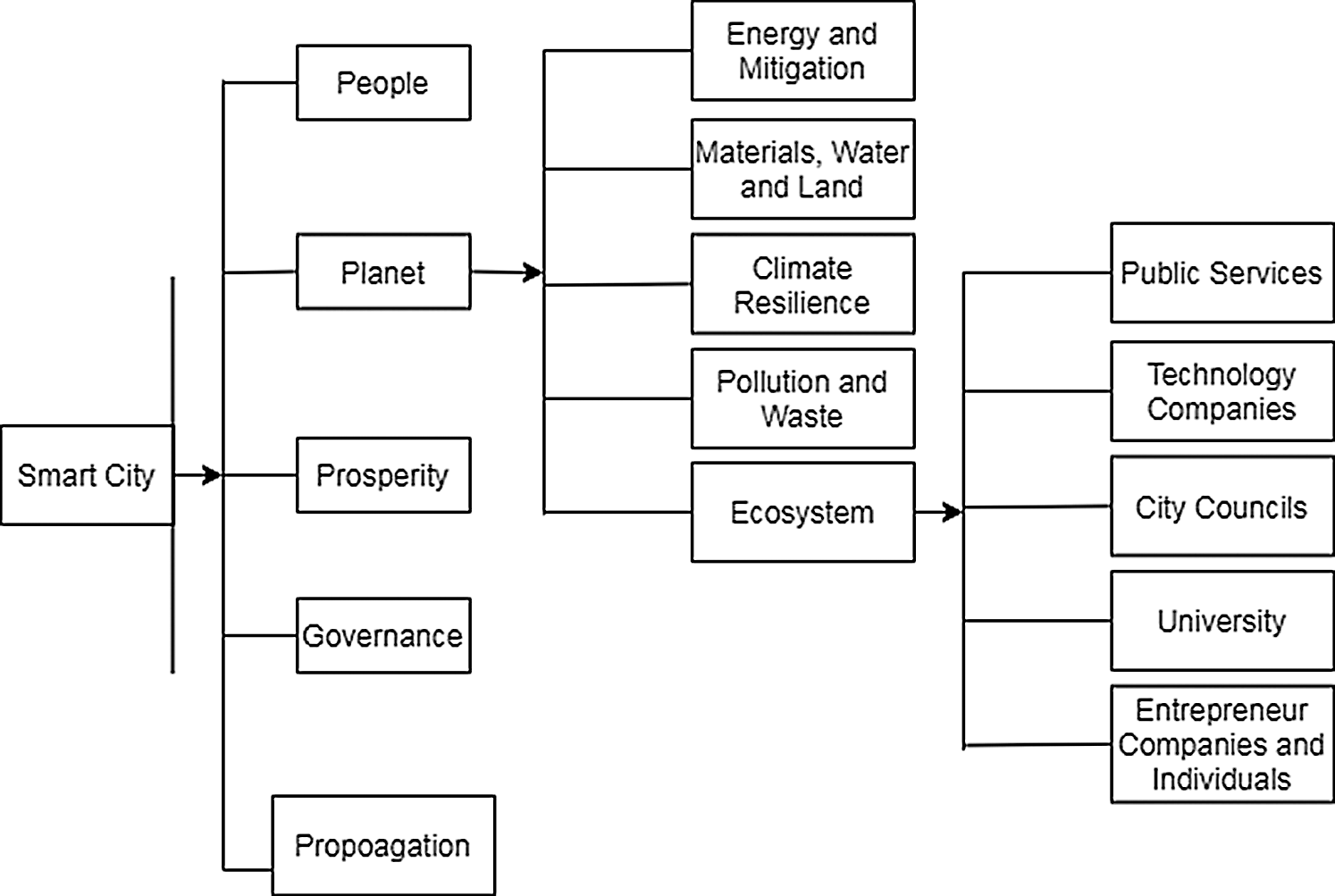
Figure 4: Smart city factors
Fig. 4 is demonstrating the important factors of a smart city. A smart city is further divided into five factors: People, Planet, Prosperity, Governance, and Propagation. The planet factor is further divided into five factors: energy and mitigation, materials, water and land, climate resilience, population and waste, and ecosystem. Improving the ecosystem’s performance is the main concern in this research, which has five factors: public services, technology companies, city councils, university and entrepreneurship companies, and individuals.
Fig. 5 demonstrates the proposed model, which consists of two phases, the first one is the training phase, and the second one is the validation phase. Both phases are linked through a cloud. The training phase involves three Layers (Sensory, Preprocessing, and Application). The Sensory layer senses the values from input parameters like Public Services, Technology Companies, City Councils, University and Entrepreneur Companies, and Individuals. It saves these values in the database via IoT. The data stored in the database can be noisy because of wireless communication. The next and very important is the preprocessing layer, which mitigates noisy data using moving average, handling missing values and normalization. After preprocessing, the output will be sent to the application layer as input. The application layer is further divided into two layers (Prediction and Performance). In the prediction layer, an ML-based approach is used to predict the ecosystem.
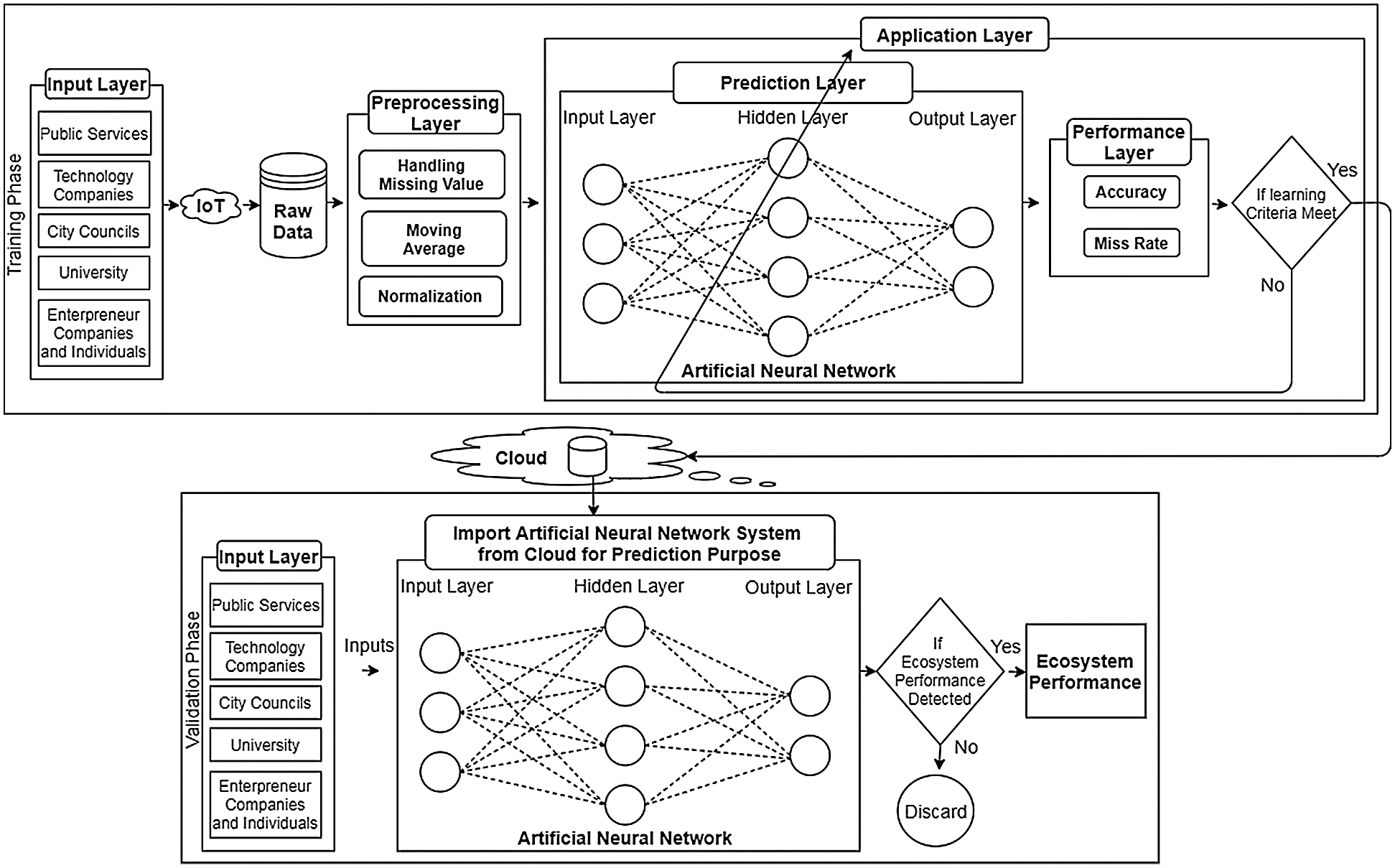
Figure 5: Proposed modelling intelligent ecosystem of smart cities using artificial neural networks
The proposed method consisted of three layers: input, output, and a hidden layer. Backpropagation was achieved using extreme machine learning, which involves various techniques for measuring error, such as weight initialization, feedforward, and backpropagation, and then updating their weight and bias. The hidden layer comprises neurons, each of which has an activation function, such as f(x) = Sigmoid (x). this function for the proposed model’s input layer and hidden layer could be read as follows:
In Eqs. (1) and (2), the input from the output layer is taken
Eq. (3) demonstrates backpropagation error where,
The layer is written as Eq. (6) rates of change in weight for the output.
Eq. (6) put on the chain rule method
Eq. (7) substitute the values obtained in Eq. (8) for both the values of weight change
where,
Use the chain rule to update the weights between the input and hidden layers
The above equation,
After simplification above equation can be written as
The weights between the output and hidden layers were modified using Eqs. (9) and (10). The weights between the hidden and input layers are updated using Eq. (11).
This proposed method consists of one hidden layer and 20 neurons, each with six inputs and one output. A two-layer feedforward approach is used in this method. The data trained the ANN into sets such as training, validation, and testing to explain the technique. Regression analysis was used to predict the method’s implementation. We test the device as a regression fit and Mean Square Error (MSE) to determine the results. If the desired outcome is not achieved, the process is retrained using a new dataset.
After the prediction layer, the output will be sent to the performance layer to predict the ecosystem’s performance in terms of Accuracy and Miss-rate and check whether the learning criteria are to meet or not. In the case of No, the prediction layer will be updated and so on, while in the case of Yes, the output value will be stored on the cloud database.
Then there the Validation phase will be activated. The input will be sensed from the Input Layer and sent to the ML approach to predict the Ecosystem performance and will be checked whether Ecosystem performance is predicted or Not. In the case of No, the process will be discarded, and in the case of Yes, the Ecosystem performance message will be displayed.
MATLAB 2019a tool is used for predicting the smartness rank of the SV. BR, SCG, and LM were used to train and fit 1385 sets of datasets randomly divide into 70% of training, 15% of validation, and 15% of testing with a different number of hidden layer neurons of the proposed model.
Three different algorithms, namely LM, BR, and SCG, have been applied to the dataset, and obtained results are shown in Tab. 2. It is clearly shown in Tab. 2; the BR algorithm has the highest accuracy. It is shown that using multiple hidden layer neurons 3(10-15 - 20), the proposed system is improving as increasing the Number of neurons, and the results of our proposed BR algorithm are better as compared to LM and SCG algorithms.

Tab. 2 also shows the performance of the proposed system with different number of Hidden Layer neurons in terms of MSE and Regression with Training and Validation. In training the MSE and Regression of LM approach by means of 10, 15 & 20 neurons are 33.1165e-6, 31.4725e-6 & 31.7974e-6 and 91.5756, 91.6008 & 92.1043 respectively. The MSE and Regression of BR approach with 10,15 & 20 neurons are 34.6154e-6, 35.3284e-6 & 35.9025e-6 and 90.6500, 90.7832 & 91.3086 respectively. The MSE and Regression of SCG approach with 10, 15 & 20 neurons are 35.6204e-6, 404771e-6 & 36.9306e-6 in addition 90.3416, 89.6994 & 89.9392 respectively.
In Validation the MSE and Regression of LM approach with 10, 15 & 20 neurons are 38.6907e-6, 42.4828e-6 & 50.2186e-6 and 87.0432, 87.7941 & 89.95008 respectively. The MSE and Regression of BR approach by means of 10, 15 & 20 neurons are 36.6907e-6, 40.4828e-6 & 48.2186e-6 and 89.6832, 90.2086 & 91.5500 respectively. The MSE in addition Regression of SCG approach with 10, 15 & 20 neurons are 31.6570e-6, 461944e-6 & 55.3208e-6 and 92.9389, 88.5523 & 89.4772 respectively.
In the context of hidden layer neurons, the proposed solution was varied with 10, 15, and 20 neurons, and it was discovered that growing neurons improved system efficiency. It also means that increasing the Number of neurons improves the system’s efficiency. The proposed BR approach has produced promising results compared to LM and SCG approaches with 20 hidden layer neurons. If in hidden layers the Number of neurons is 20, LM gives 50.2186e-6MSE and 89.95008regression, BR gives 48.2186e-6MSE and 91.5500 regression, and the SCG gives 55.3208e-6 MSE and 89.4772 Regression in Validation, with this. It is observed that Bayesian Regularization gives stunning results in terms of MSE and Regression when hidden layer neurons are 15 as associated to Levenberg Marquardt and Scale Conjugate. It was seen that the BR algorithm has the highest accuracy rate, with 91.55%.
A smart city is the dream of innovation, creativity, better way of life for the future, where people can live with smart and intelligent gadgets and can communicate with the world in the more advanced and fastest way. A smart city is a way to change the social and economical way of life. This research incorporates an intelligent ecosystem using the IoT and designed for a smart city. This research defines a smart city to predict the ecosystem immediately by implementing ANN approaches. The framework is developed using Cloud and IoT to facilitate storage, index, and data visualization generated through a smart city’s input parameters. The SCG, LM, and BR algorithms are implemented with an ANN-based proposed approach to develop a predictive and smart ecosystem model. The proposed system’s evaluation shows that the BR algorithm gives promising results in accuracy and Miss rate. The predicted accuracy of the proposed model shows 91.55% performance in the ecosystem on the given factors.
Acknowledgement: Thanks to our families & colleagues who supported us morally.
Funding Statement: The authors received no specific funding for this study.
Conflicts of Interest: The authors declare that they have no conflicts of interest to report regarding the present study.
1. H. Arasteh, V. Hosseinnezhad, V. Loia, A. Tommasetti, O. Troisi et al., “Iot-based smart cities: A survey,” in 2016 IEEE 16th Int. Conf. on Environment and Electrical Engineering, Florence, Italy, pp. 1–6, 2016. [Google Scholar]
2. M. Batty, K. W. Axhausen, F. Giannotti, A. Pozdnoukhov, A. Bazzani et al., “Smart cities of the future,” European Physical Journal Special Topics, vol. 214, no. 1, pp. 481–518, 2012. [Google Scholar]
3. R. B. Uriarteac, R. D. Nicolaa, V. Scocaa and F. Tiezzib, “Defining and guaranteeing dynamic service levels in clouds,” Future Generation Computer Systems, vol. 99, no. 1, pp. 27–40, 2019. [Google Scholar]
4. M. Aazam, I. Khan, A. A. Alsaffar and E. N. Huh, “Cloud of things: integrating internet of things and cloud computing and the issues involved,” in Proc. of 2014 11th Int. Bhurban Conf. on Applied Sciences & Technology (IBCAST) Islamabad, Pakistan, Islamabad, Pakistan, pp. 414–419, 2014. [Google Scholar]
5. E. G. Carayannis and R. Rakhmatullin, “The quadruple/quintuple innovation helixes and smart specialization strategies for sustainable and inclusive growth in Europe and beyond,” Journal of the Knowledge Economy, vol. 5, no. 2, pp. 212–239, 2014. [Google Scholar]
6. A. Akande, P. Cabral, P. Gomes and S. Casteleyn, “The Lisbon ranking for smart sustainable cities in Europe,” Sustainable Cities and Society, vol. 44, no. 4, pp. 475–487, 2019. [Google Scholar]
7. Z. Iker, S. Alessandro and A. Saioa, “Smart city concept: What it is and what it should be,” Journal of Urban Planning and Development, vol. 142, no. 1, pp. 04015005–0415007, 2016. [Google Scholar]
8. Y. Wu, W. Zhang, J. Shen, Z. Mo and Y. Peng, “Smart city with Chinese characteristics against the background of big data: Idea, action and risk,” Journal of Cleaner Production, vol. 173, no. 4, pp. 60–66, 2018. [Google Scholar]
9. C. Lim, K. Kim and P. P. Maglio, “Smart cities with big data: Reference models, challenges, and considerations,” Cities, vol. 82, no. 1, pp. 86–99, 2018. [Google Scholar]
10. A. R. Honarvar and A. Sami, “Towards sustainable smart city by particulate matter prediction using urban big data,” Excluding Expensive Air Pollution Infrastructures, vol. 17, pp. 56–65, 2018. [Google Scholar]
11. R. Wenge, X. Zhang, C. Dave, L. Chao and S. Hao, “Smart city architecture: A technology guide for implementation and design challenges,” China Communications, vol. 11, no. 3, pp. 56–69, 2014. [Google Scholar]
12. R. Kitchin, “The real-time city? Big data and smart urbanism,” GeoJournal, vol. 79, no. 1, pp. 1–14, 2014. [Google Scholar]
13. M. Batty, J. Shen, F. Giannotti, A. Pozdnoukhov, A. Bazzani et al., “Smart cities of the future,” European Physical Journal Special Topics, vol. 214, no. 1, pp. 481–518, 2012. [Google Scholar]
14. N. Osada, R. Miyagi and A. Takahashi, “Cis-and trans-regulatory effects on gene expression in a natural population of Drosophila melanogaster,” Genetics, vol. 206, no. 4, pp. 2139–2148, 2017. [Google Scholar]
15. P. M. Sousa, A. M. Ramos, C. C. Raible, M. Messmer, R. Tomé et al., “North atlantic integrated water vapor transport—from 850 to 2100 ce: impacts on western european rainfall,” Journal of Climate, vol. 33, no. 1, pp. 263–279, 2020. [Google Scholar]
16. T. D. Ge, D. D. Wang, Z. K. Zhu, L. Wei, X. M. Wei et al., “Tracing technology of carbon isotope and its applications to studies of carbon cycling in terrestrial ecosystem,” Chinese Journal of Plant Ecology, vol. 44, no. 4, pp. 360–372, 2020. [Google Scholar]
17. A. Fatima, S. Abbas, M. Asif and M. S. Khan, “Optimization of governance factors for smart city through hierarchical mamdani type-1 fuzzy expert system empowered with intelligent data ingestion techniques,” EAI Endorsed Transactions on Scalable Information Systems, vol. 6, no. 23, pp. 1–6, 2019. [Google Scholar]
 | This work is licensed under a Creative Commons Attribution 4.0 International License, which permits unrestricted use, distribution, and reproduction in any medium, provided the original work is properly cited. |